Terminated Fiber Adapters
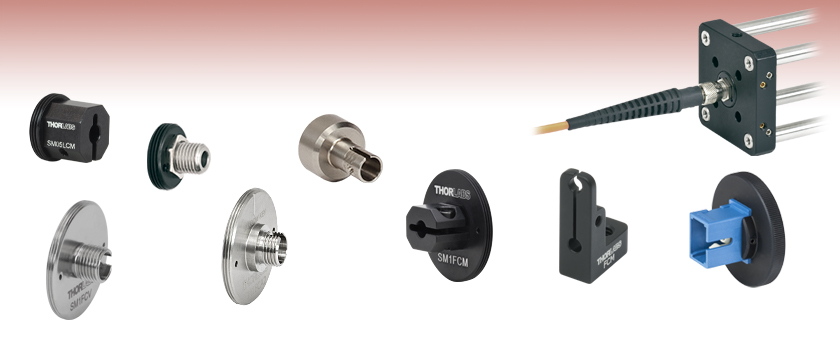
- Compatible with Lens Tubes, Optical Posts, Standard C-Mounts, or OEM Components
- Options for FC/PC, FC/APC, SMA, ST®/PC, SC/PC, and LC®/PC Connectors
- SM05- and SM1-Threaded Adapters and Post-Mountable Clamps for Ferrules
SM1FCV
Vacuum-Compatible
FC/PC Adapter,
2.2 mm Wide Key
SM05SMA
SMA Adapter
SM1FCA2
FC/APC Adapter,
2.0 mm Narrow Key
PM20-ST
ST®/PC Adapter
SM1FCM
Ø2.5 mm Ferrule Adapter
FCM
Ø2.5 mm Ferrule Clamp
SM05SMA Fiber Adapter in an
SM05-Threaded
Cage Plate
S120-SC
SC/PC Adapter
SM05LCM
Ø1.25 mm Ferrule Adapter

Please Wait
Threaded & Unthreaded Adapters
Thorlabs offers various types of fiber connector adapters, which allow the most common types of fiber connectors to be integrated with SM-threaded, C-Mount-threaded, or unthreaded components. Adapters for patch cables with narrow or wide key FC/PC, narrow or wide key FC/APC, SMA, ST®*/PC, SC/PC, or LC®/PC connectors are available; for more details on narrow versus wide key connectors, please see the Key Alignment tab. Vacuum-compatible wide key FC/PC and SMA conectors are available with external SM1 threading. Adapters without a locking connector mechanism are available for patch cables with a Ø2.5 mm ferrule end. We also offer flexure clamp adapters that allow our patch cables with a Ø1.25 mm or Ø2.5 mm ferrule end to be mounted within an SM05-threaded (0.535"-40) or SM1-threaded (1.035"-40) component. If the threading and connector combination you need is not shown below, please contact Tech Support. Our complete line of thread adapters can also be used to convert between threadings.
These adapters are commonly employed when building free-space single mode or multimode fiber couplers and collimators or in other free-space coupling applications. They can also be utilized to provide light-tight coupling to our SM05 (0.535"-40)- or SM1 (1.035"-40)-threaded photodetectors and many of our power meter sensors. Our C-mount-threaded fiber adapters are useful for connecting patch cables to our C-mount cameras.
Bulkhead Adapters
Thorlabs' FC/PC, SMA, and ST/PC Bulkhead Adapters contain one connector for applications that require the projection of light into free space (the ST/PC adapters are also available in packs of ten). Their compact size and mounting threads make them ideal for OEM or custom applications. Our FC/PC and SMA bulkhead adapters boast a one-piece construction that integrates easily with a custom application, while a compatible 3/8"-24 lock nut is sold separately for the ST/PC bulkhead adapter for OEM applications. The design of the adapters aligns the front face of the connector ferrule with the rear surface of the adapter. This allows the fiber to be placed in near-physical contact with any optics or instruments that are placed after the adapter.
Post-Mounting Adapters
Post-Mountable Ferrule Clamps are designed to hold fiber connectors securely and compactly in an experimental setup. Clamps are available for Ø1.25 mm, Ø2.5 mm, Ø3.2 mm, or Ø3.4 mm components, including FC/PC, FC/APC, SC/PC, ST/PC, and SMA connectors, as well as our GRIN fiber optic collimators. The flexure clamps include an 8-32 (M4) tapped hole for post mounting, and they use a 5/64" (2 mm) hex key to secure the ferrule.
*ST® is a registered trademark of Lucent Technologies, Inc.
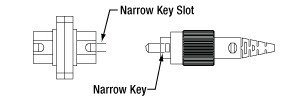
Click to Enlarge
Mating Between a Narrow-Key Mating Sleeve and Connector
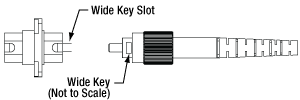
Click to Enlarge
Mating Between a Wide-Key Mating Sleeve and Connector
FC/PC and FC/APC Patch Cable Key Alignment
FC/PC and FC/APC Patch Cables are equipped with either a 2.0 mm narrow or 2.2 mm wide alignment key that fits into a corresponding slot on a mated component. These keys and slots are essential to correctly align the cores of connected fiber patch cables and minimize the insertion loss of the connection.
As an example, Thorlabs designs and manufactures mating sleeves for FC/PC- and FC/APC-terminated patch cables to precise specifications that ensure good alignment when used correctly. To ensure the best alignment, the alignment key on the patch cable is inserted into the corresponding narrow or wide-key slot on the mating sleeve.
Wide-Key-Slot Mating Sleeves
2.2 mm wide-key-slot mating sleeves are compatible with both wide-key and narrow-key connectors. However, using a narrow-key connector in a wide-key slot will allow the connector to rotate slightly in the mating sleeve (as shown in the animation below and to the left). While this configuration is acceptable for patch cables with FC/PC connectors, for FC/APC applications, we recommend using narrow-key-slot mating sleeves to ensure optimum alignment.
Narrow-Key-Slot Mating Sleeves
2.0 mm narrow-key-slot mating sleeves allow for optimal alignment of angled, narrow-key FC/APC connectors, as shown in the animation below and to the right. Therefore, they are not compatible with connectors that have a 2.2 mm wide key. Please note that all FC/PC and FC/APC patch cables manufactured by Thorlabs use narrow key connectors.
Once a narrow key connector is inserted into a narrow-key-slot mating sleeve, the connector will not rotate. We therefore recommend these mating sleeves for FC/PC and FC/APC connectors with narrow keys.
When a narrow key connector is inserted into a wide-key-slot mating sleeve, the connector has room to rotate. For narrow key FC/PC connectors, this is acceptable, but for narrow key FC/APC connectors, significant coupling losses will result.
Insights into Optical Fiber
Scroll down to read about:
- What factors affect the amount of light coupled into a single mode fiber?
- Is the max acceptance angle constant across the core of a multimode fiber?
Click here for more insights into lab practices and equipment.
What factors affect the amount of light coupled into a single mode fiber?
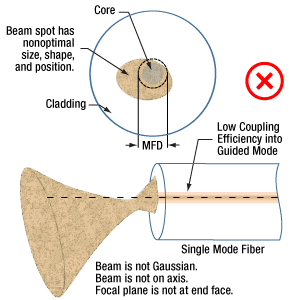
Click to Enlarge
Figure 2 Conditions which can reduce coupling efficiency into single mode fibers include anything that reduces the similarity of the incident beam to the optical properties of the fiber's guided mode.
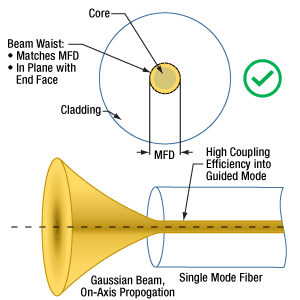
Click to Enlarge
Figure 1 For maximum coupling efficiency into single mode fibers, the light should be an on-axis Gaussian beam with its waist located at the fiber's end face, and the waist diameter should equal the MFD.
Adjusting the incident beam's angle, position, and intensity profile can improve the coupling efficiency of light into a single mode optical fiber. Assuming the fiber's end face is planar and perpendicular to the fiber's long axis, coupling efficiency is optimized for beams meeting the following criteria (Figure 1):
- Gaussian intensity profile.
- Normal incidence on the fiber's end face.
- Beam waist in the plane of the end face.
- Beam waist centered on the fiber's core.
- Diameter of the beam waist equal to the mode field diameter (MFD) of the fiber.
Deviations from these ideal coupling conditions are illustrated in Figure 2.
These beam properties follow from wave optics analysis of a single mode fiber's guided mode (Kowalevicz).
The Light Source can Limit Coupling Efficiency
Lasers emitting only the lowest-order transverse mode provide beams with near-Gaussian profiles, which can be efficiently coupled into single mode fibers.
The coupling efficiency of light from multimode lasers or broadband light sources into the guided mode of a single mode fiber will be poor, even if the light is focused on the core region of the end face. Most of the light from these sources will leak out of the fiber.
The poor coupling efficiency is due to only a fraction of the light in these multimode sources matching the characteristics of the single mode fiber's guided mode. By spatially filtering the light from the source, the amount of light that may be coupled into the fiber's core can be estimated. At best, a single mode fiber will accept only the light in the Gaussian beam output by the filter.
The coupling efficiency of light from a multimode source into a fiber's core can be improved if a multimode fiber is used instead of a single mode fiber.
References
Kowalevicz A and Bucholtz F, "Beam Divergence from an SMF-28 Optical Fiber (NRL/MR/5650--06-8996)." Naval Research Laboratory, 2006.
Date of Last Edit: Jan. 17, 2020
Is the max acceptance angle constant across the core of a multimode fiber?
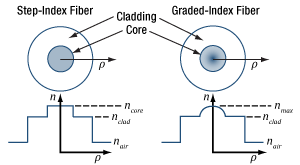
Click to Enlarge
Figure 3: Step-index multimode fibers have an index of refraction ( n ) that is constant across the core. Graded-index multimode fibers have an index that varies across the core. Typically the maximum index occurs at the center.
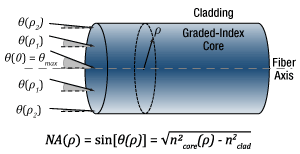
Click to Enlarge
Figure 5: Graded-index multimode fibers have acceptance angles that vary with radius ( ρ ), since the refractive index of the core varies with radius. The largest acceptance angles typically occur near the center, and the smallest, which approach 0°, occur near the boundary with the cladding
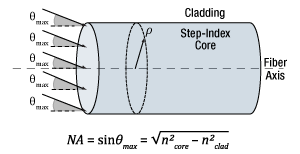
Click to Enlarge
Figure 4: Step-index multimode fibers accept light incident in the core at angles ≤|θmax | with good coupling efficiency. The maximum acceptance angle is constant across the core's radius ( ρ ). Air is assumed to surround the fiber.
It depends on the type of fiber. A step-index multimode fiber provides the same maximum acceptance angle at every position across the fiber's core. Graded-index multimode fibers, in contrast, accept rays with the largest range of incident angles only at the core's center. The maximum acceptance angle decreases with distance from the center and approaches 0° near the interface with the cladding.
Step-Index Multimode Fiber
The core of a step-index multimode fiber has a flat-top index profile, which is illustrated on the left side of Figure 3. When light is coupled into the planar end face of the fiber, the maximum acceptance angle (θmax ) is the same at every location across the core (Figure 4). This is due to the constant value of refractive index across the core, since the acceptance angle depends strongly on the index of the cladding.
Regardless of whether rays are incident near the center or edge of the core, step-index multimode fibers will accept cones of rays spanning angles ±θmax with respect to the fiber's axis.
Graded-Index Multimode Fibers
The core of a typical graded-index multimode fiber, shown on the right side of Figure 3, has a refractive index that is greatest at the center of the core and decreases with radial distance ( ρ ). The equation included below the diagram in Figure 5 shows that the radial dependence of the core's refractive index results in a radial dependence of the maximum acceptance angle and numerical aperture (NA). This equation also assumes a planar end face, normal to the fiber's axis that is surrounded by air.
Cones of rays with angular ranges limited by the core's refractive index profile are illustrated Figure 5. The cone of rays with the largest angular spread
Step-Index or Graded Index?
A step-index multimode fiber has the potential to collect more light than a graded-index multimode fiber. This is due to the NA being constant across the step-index core, while the NA decreases with radial distance across the graded-index core.
However, the graded-index profile causes all of the guided modes to have similar propagation velocities, which reduces the modal dispersion of the light beam as it travels in the fiber.
For applications that rely on coupling as much light as possible into the multimode fiber and are less sensitive to modal dispersion, a step-index multimode fiber may be the better choice. If the reverse is true, a graded-index multimode fiber should be considered.
References
Keiser G, "Section 2.6." Optical Fiber Communications. McGraw-Hill, 1991.
Date of Last Edit: Jan. 2, 2019
| Posted Comments: | |
wentao ye
(posted 2024-10-09 03:29:28.01) we need Ferrule Adapter Plate with an 8 degree bevel ferrule EGies
(posted 2024-10-14 05:20:58.0) Thank you for contacting Thorlabs. We do not currently have a ferrule adapter plate made to accommodate an angled ferrule. I have contacted you directly to discuss our custom capabilities and your specific application requirements. user
(posted 2023-10-20 09:22:14.193) Does Thorlabs manufacture any mounts for QBH style high power fiber connectors? These are common for very high power fibers, and it would be useful to have connectors between these fibers and standard optical & optomechanical components. cdolbashian
(posted 2023-11-08 09:37:37.0) Thank you for reaching out to us with this inquiry! While we do not sell these components currently, I have submitted this request internally with the hope that it will become a catalogue offering in the future. Sanghyo Park
(posted 2023-03-20 17:37:10.613) How much the angle deviation of this terminal from optical axis? user
(posted 2023-01-24 14:43:44.127) We want to use one of these terminated fiber adapters in a gimbal mount to rotate the fiber without changing its position (for example, Thorlabs gimbal mount GMB1). The only problem I see with this is that the fiber adapters position the fiber some distance away from the front of the adapter, so the fiber would align to the rotation axis of the gimbal. Many have a distance of about 0.2 mm from the fiber facet to the front of the mounting surface (where the gimbal rotation axis would be); for example: SM1FC2. I have not found a fiber adapter in which the fiber facet is aligned to the adapter's mounting surface (the threads or other edge that would contact the gimbal mount). Perhaps this could be a new product: a terminated fiber adapter that aligns the fiber facet to the mounting surface of the adapter to within some reasonable tolerance. li yancheng
(posted 2022-06-29 03:16:57.51) what is the material of the black plastic?
is PET or HDPE or PCV?
Thanks! jdelia
(posted 2022-06-29 08:03:35.0) Thank you for contacting Thorlabs. The FCM/M is made out of anodized 6061-T6 aluminum. li yancheng
(posted 2022-06-15 15:32:36.947) the SECURING CAP SCREW
2.0mm [5/64in] HEX on the top ofFCM13/M,what is the Specification of SECURING CAP SCREW?
Is this cap screw is SH2S019?
https://www.thorlabs.de/newgrouppage9.cfm?objectgroup_id=5894&pn=SH2S019#10180 jdelia
(posted 2022-06-15 01:50:47.0) Thank you for contacting Thorlabs. The screw used is a 2-56 cap screw that is 1/8" shorter than the SH2S019. I have reached out to you directly regarding your application. Jesus Lopez
(posted 2022-06-08 17:28:37.557) Can you tell me what material your part number SM05FCA is made from?
Thank you,
Jesus Lopez jdelia
(posted 2022-06-09 12:54:36.0) Thank you for contacting Thorlabs. This part is made out of 303 stainless steel. Liam Collard
(posted 2022-01-19 09:42:32.527) Hello there,
I have a "SM1LCM" for which I wish to moutn a 1.25 mm metalic ferrule in. The fiber is custom made and therefore does not have the delrin sleeve.
Can you propose a solution to mount the 1.25mm ferrule in the mount? Is there a possibility to add the delrin sleeve onto the ferrule myself?
Many thanks,
Liam jgreschler
(posted 2022-01-26 09:54:05.0) Thank you for reaching out to Thorlabs. You can request quotes for components of our stock fiber product line by contacting techsupport@thorlabs.com. I have reached out to you directly to discuss setting up a quote. OHSOUNG KWON
(posted 2022-01-05 00:33:14.663) Dear Thorlabs,
I have a question after saw 'Detail Y' drawing.
There is a distance from ferrule end face of optical fiber to emission surface.
However, when I assembly 3D model with S05FC2 and FC/APC patch cable, the end face of ferrule can not be 1.5mm from the emission surface.
Because, the end of slop edge of ferrule contacts down side corner of S05FC2 first.
Could you find out for me?
To make conic mirror, I need to know exact distance of end face of ferrule.
If you need assembled 3D Model, I can send to you.
Regards,
OHSOUNG KWON jgreschler
(posted 2022-01-21 03:44:28.0) Thank you for reaching out to Thorlabs. For general inquiries, please email techsupport@thorlabs.com. I have reached out to you directly to discuss this application further. Holger Netz
(posted 2021-09-06 09:09:02.18) This connector is not light tight. Light is leaking through at the flat cut-outs of the metallic connector (see backside view). Please reconsider the design. azandani
(posted 2021-09-16 11:09:37.0) Hello Holger, thank you for contacting Thorlabs and thank you for the feedback, we truly appreciate it. We are always looking for ways to improve our products and we will reach out to you directly to discuss this further. user
(posted 2021-05-06 10:44:04.573) Hello, I m looking for the distance value between the fiber tip and the adaptator front surface for the HASMA adaptator.
Does it 0,84 mm as for the SM05FC or it's another normalization for sma? Thank you cdolbashian
(posted 2021-05-12 05:31:33.0) Thank you for contacting Thorlabs! The Length of the SMA tip which can house the HASMA can be anywhere between ~9.779-9.812mm while the length of the HASMA is ~9.652mm. When fully inserted into the HASMA, the ferrule tip will protrude by ~147-160um. Laurie Paez
(posted 2021-04-21 11:35:35.613) I work in the Document Control dept. I'm responsible for obtaining all the documents for our system (datasheet, RoHS cert.) It would be nice to have the RoHS cert. available for download.
Thank you,
Laurie Paez YLohia
(posted 2021-04-21 01:52:21.0) Hello Laurie, thank you for your feedback and bringing this bug to our attention. We will fix the RoHS cert download link for the S120-APC2. Jakob Vorlaufer
(posted 2020-03-24 13:16:01.79) It would be great to have a version of the SM1FCA with a narrow-angle key. As far as I can see, all (or at least most) of your fiber patch cables have the narrow key, and according to your costumer support, a misalignment can have detrimental effects to coupling efficiency, especially for PM fibers. I did not find any comparable products on your website or the Newport website. While your fiber ports of course come for narrow keys as well, for us it is virtually always far more convenient and cost-efficient if we can simply integrate the fiber coupling into an optical setup by screwing the adapter in a SM1 cage plate or similar.
Please let me know if you have any further questions or comments regarding my suggestion. YLohia
(posted 2020-03-24 03:00:06.0) Hello Jakob, thank you for contacting Thorlabs and your valuable suggestion. We will consider adding this product to our catalog. Dominik Dörich
(posted 2019-11-05 08:09:12.477) Hi,
we need an "EU Declaration of Conformity" for RoHS but it's not possible to open it. After clicking on the icon on the HAFC-FC/PC-Webpage (https://www.thorlabs.com/thorproduct.cfm?partnumber=HAFC) we get an error:
"Sorry unable to get certificate info."
URL:
https://www.thorlabs.com/RoHS_cert.cfm?rohs=A(compliant%20EU%202015/863)&pn=HAFC
For other products like the HASMA it works without any problems.
Please send us the certificate by email and/or repair the link to the certificate page for the HAFC - FC/PC Bulkhead Adapter.
Thank you and best regards
Dominik Dörich YLohia
(posted 2019-11-05 10:43:43.0) Hello Dominik, thank you for contacting Thorlabs. We are sorry to hear about the issues caused by the broken RoHS link. We will reach out to you via email with the proper certification. Ross Finlay
(posted 2019-10-04 23:14:58.923) Hi, Can you tell me the distance between the end face of the inserted fiber and the front surface of the SM05SMA adapter?
I saw the Q&A for the FC version (0.84mm), but it may not be the same.
Thanks, Ross nbayconich
(posted 2019-10-10 10:30:29.0) Thank you for contacting Thorlabs. These adapters will protrude by about 0.1524mm with respect to the adapter surface. SMA connectors have a height standard between 0.3850" to 0.3863" so there can be a small 0.033mm variation. user
(posted 2019-08-23 15:49:26.62) I see the bulkhead is available without the plate, but I would like to buy the SM1 plate without the bulkhead. The SM1PL would be perfect but it's too thick.
So would it be possible to buy the thin SM1 plate? nbayconich
(posted 2019-08-23 04:47:24.0) Thank you for contacting Thorlabs. I'll reach out to you directly to discuss our custom capabilities. Ilya Solovyev
(posted 2019-06-20 13:27:52.187) Dear Sirs,
What is the principle of SMA connector fixing in the SM1SMA adapter? Is it female SMA thread? I need make male SMA to SM1 tube connection. Is it possible to unscrew SMA connector from SM1SMA and mount the SM1 ring to the SMA male?
Thanks! YLohia
(posted 2019-06-21 10:40:48.0) Hello, fiber patch cables are meant to directly screw into the SM1SMA. This adapter has a male/external SMA thread. Unfortunately, it's not possible to unscrew the SMA connector from this adapter. I have reached out to you directly to gather more details about your application. user
(posted 2019-06-13 12:09:40.83) We ordered 2 of those.
They are both incredibly poorly manufactured, and the "thread" is only barely matching FC-PC connector.
When we try to connect a (Thorlabs) FC-PC fiber, it feels as there is sand in the thread (even if its clean), and I had to use a plyer to manage to screw entirely the connector.
This would be a ridiculously overpriced item if it was actually doing the job. But considering what we got for 27.70€ I cannot call it anything else than a robbery.
I would strongly advice anyone to put his finger in an electrical socket rather than buying this product, it shoud definitely be a more pleasant experience.
Hoping I will never have to order from you again,
A displeased PHD student. YLohia
(posted 2019-06-13 04:04:13.0) Hello, thank you for your feedback. We take the quality of our products seriously here at Thorlabs so please accept our apologies for any issues caused by this item. We would be happy to offer inspected replacements for these two pieces as this is not an issue that we have encountered before. Since we do not have your contact information, please contact your local Thorlabs Tech Support team to request a replacement. user
(posted 2019-05-17 19:49:17.123) I have been attempting to use this connector to collimate the output from a LC connected fiber. Unfortunately the LC connector on this part is very loose and allows the fiber to slide back and forth by about 0.5mm and collimation is easily disturbed. Other LC connector parts I am using are not this loose, so this part is disappointing and a weak link in my system. llamb
(posted 2019-05-23 12:13:14.0) Thank you for bringing this to our attention. After troubleshooting and checking internal stock, it appears the design is indeed faulty for the externally threaded LC terminated fiber adapters, which has led to the slop/play that you are seeing during collimation. We are looking to improve upon this design. I sincerely apologize for the inconvenience and will reach out to you directly to set up a reimbursement. user
(posted 2019-05-02 20:08:55.5) Hi,
Do you have a similar adapter cap with internal SM1 threads for MT ferrule (with 8 degree APC front face)?
Thanks, YLohia
(posted 2019-05-03 03:04:30.0) Hello, thank you for contacting Thorlabs. Unfortunately, we do not currently offer this. robert
(posted 2018-11-21 21:15:53.49) These adapters are very useful thanks. We would also like a version of S120-FC for FC/APC cables, like the S1FCA but internal SM1 thread. We use S120-FC with your power meters, to measure power out of a fiber. We use a short SM1 tube so the beam can expand, to avoid saturating the power sensor. With an FC/APC on an S120-FC, the propagated light does not hit the sensor on-center, so not all the light is detected. Thanks for your consideration. nbayconich
(posted 2018-11-28 10:54:56.0) Thank you for contacting Thorlabs. I will reach out to you to discuss our custom capabilities. As an alternative you can use the SM1FCA with the internally threaded SM1T1 coupler. akn
(posted 2018-07-01 23:32:15.017) Regarding SM1FCA,kindly clarify asap:
- Operating temperature range
- Storage temperature range
- Weight in gms YLohia
(posted 2018-07-03 10:01:44.0) Hello, we do not specify any of these parameters other than the weight (approximately 10g). This is made of 303 Stainless Steel, so you can look up the relevant properties online to get a sense of operating/storage temperature. leticia.tarruell
(posted 2018-03-07 12:29:31.81) Has Thorlabs any terminated adapter for SMA fiber connectors (such as S1SMA) with a 5º angle?
That would be the equivalent of S1FCA (vs. SM1FC) but for angled SMA. Thanks! llamb
(posted 2018-03-14 11:02:19.0) Hello, thank you for contacting Thorlabs. We do not currently have any angled SMA connectors, as SMA is also not a keyed connector. I will reach out to you directly to discuss alternatives and our custom capabilities. jv
(posted 2017-09-05 10:52:45.03) Is there an S120 type adapter available with a solid, blank face? (Like a cap) wskopalik
(posted 2017-09-07 10:09:21.0) This is a response from Wolfgang at Thorlabs. Thank you for your inquiry.
There is an internally SM1-threaded end cap which has the item number SM1CP1. I think this is what you are looking for.
I have also contacted you directly to provide further assistance. pierrick.cheiney
(posted 2017-06-21 14:11:04.07) Hello,
What is the tolerance on the tilt if I use a S1FCA connector in a SM1 lens mount (locked with a retaining ring).
Thanks, nbayconich
(posted 2017-07-11 03:42:16.0) Thank you for contacting Thorlabs. The mechanical angle of the fc/apc bulkhead has a standard tolerance of 4.05° ±30’(0.5°). The tilt of the z axis will depend on the components used together.
For example If you were to mount S1FCA in something like LMR1 there is a perpendicularity spec of 0.002” over 1” between the SM1 bore and the mounting hole. Arctan(0.002)=0.115°, so then they would stack to ±0.62°. I will contact you directly about your application. lucia.koubikova
(posted 2017-06-08 16:53:15.537) Hello, I am wondering, if there is a terminated fiber adapter that could be used together with the Vacuum-Compatible Multimode Fiber Optic Patch Cable in a setup inside a vacuum chamber. I would like to place the fiber in a Polaris mirror mount but I do not see any appropriate (vacuum and SMA905 compatible) adapter over here. Could you, please, give me some recommendation? nbayconich
(posted 2017-07-13 05:14:26.0) Thank you for contacting Thorlabs. These terminated fiber adapters are not intended for use in a vacuum. The black anodization of the SM1SMA and SM05SMA adapters is not vacuum compatible. These SMA connectors are also made from 303 stainless steel which is not good for vacuum use. I will contact you directly about our custom capabilities. richard
(posted 2017-02-06 14:36:32.98) I have a question about the S05FC adapter plate.
Is this a 2-piece construction, i.e. is is essentially a HFCA Bulkhead Adapter (silver part) threaded into an adapter (black) with 0.5" OD?
The reason for the question is that I have been using the SM05FC (external SM05 thread) which has this kind of 2-piece construction. I have been unable to achieve satisfactory centration. Even a custom centering ring referenced to the proud part of the HFCA won't work as there is less than 1 full thread proud of the black outer ring.
I want to know if I use a S05FC, is the external 0.5" diameter going to be concentric to the fiber to within machining accuracy? (As it would be if parts are pressed rather than screwed together).
I note that there does appear to be an adapter which looks like a 1-piece construction, the S05FCA. Unfortunately this seems only available for FC/APC. tfrisch
(posted 2017-02-14 03:14:19.0) Hello, thank you for contacting Thorlabs. The two haves of S05FC are joined by 3/8"-24 threads. I will reach out to you directly regarding your needs for this application. daaf.sandkuijl
(posted 2015-07-30 07:25:30.967) Using an FC/PC fiber adapter (such as PM20-FC) and an FC/PC connectorized fiber, what would be the typical repeatability from one adapter to the next and one fiber to the next in terms of centration of the fiber in the adapter (in microns), and in terms of tip/tilt error (in degrees)? besembeson
(posted 2015-09-24 09:06:39.0) Response from Bweh at Thorlabs USA: We have not accessed such figures. However, this will largely depend on the tolerances of both the fiber and the adapter. The manufacturing based centration of the ferrule duct to the outer diameter is better than 20um. Then there is the deviation of the SM05 thread of the adapter that could be biggest. This is manufactured with an average tolerance of 2A (ISO tolerance system) and the sensor thread will be of class 2B but we have no figures on the centricity or tip/tilt error when these are screwed together. scottie730318
(posted 2014-04-18 12:01:26.53) Dear Sir:
Is the "Externally SM1-Threaded Fiber Adapters" for SM1SMA only one size with Ø1" (25.4mm)for Precision XY Translation Mounts(LM1XY)? Is there SM1SMA with size for 25mm for LM1XY/M?
Thanks
Best Regards jlow
(posted 2014-04-18 03:10:04.0) Response from Jeremy at Thorlabs: The only difference between the LM1XY and the LM1XY/M is the mounting hole on the bottom (#8-32 vs. M4). The central bore for LM1XY (/M) is SM1 threaded so the SM1SMA would be used in both the English and metric version. mtandecki
(posted 2014-01-24 19:08:14.113) I would like to suggest an addition to the Thorlabs product line. We are using these FC/APC fiber adapters typically with the CP02 cage plates. However, we have two issues when doing so:
1. It is not that easy to have the key of the FC adapter align perfectly parallel with one of the sides of the cage plate, which is what we aim for when using PM fiber.
2. The light beam probably comes out perpendicular to the FC adapter, however, because of the thread between SM1FCA and CP02 the beam is not perpendicular to the cage plate anymore. In some cases it has been so bad that we had to rearrange an optics setup because subsequent mirrors wouldn't be able to compensate for this.
Making a combined SM1FCA/CP02 part could easily get rid of these two issues during the production process. Same goes for the SM1FC adapters which we sometimes use for non-angled PM fiber. Other suggestions to remedy these two issues are also welcome. alex.lambert
(posted 2013-07-18 09:07:41.3) How much angular misalignment, if any, would result from inserting a 2.0mm narrow key FC/APC connector into the SM1FCA adaptor's 2.2mm wide key? Will the output beam still be perpendicular to the adapter's face? jlow
(posted 2013-07-22 15:46:00.0) Response from Jeremy at Thorlabs: The angular misalignment from the 0.2mm would be <1.8°. The output beam should still be quite perpendicular to the adapter's face since the angular misalignment is quite small. tor
(posted 2010-11-12 14:55:33.0) A response from Tor at Thorlabs to johannes.trapp: Thank you for your interest in the SM05FC. The distance from the fiber tip to the adapters front surface is 0.84mm. johannes.trapp
(posted 2010-11-12 11:00:38.0) whats the distance between the end facet of the inserted fiber and the surface of the adapter, i.e. how close can I get the fiber end (in the adapter) to an object if the adapter is placed directly onto that object?
thanks Greg
(posted 2010-09-28 13:26:55.0) A response from Greg at Thorlabs to lincoln.turner: Our SM1FCA is designed for a key width of 0.085" +0.0003/-0.0 (2.16 mm +0.008/-0.0), allowing it to accept either narrow or wide key widths. We will look into adding a narrow key version of these adapters to increase repeatability for customers like yourself. For the time being, we can offer wide key FC/APC connectors on custom patch cables, which will provide a more repeatable fit with our SM1FCA and SM05FCA. lincoln.turner
(posted 2010-09-28 19:50:30.0) A great addition to your product line would be a version of the SM1FCA (and S05FCA) fiber adapters that are designed for PM fiber. Currently the key width on these plates is 2.3-2.4mm which does not match either the industry standard 2.1mm wide key or 2.0mm narrow key. Currently when you use your PM fiber patch leads (they have a narrow key) it is impossible to remove and reconnect the patch lead while maintaining a stable polarisation as the key can rotate by 1-2 degrees in the SM1FCA plate! Laurie
(posted 2009-04-13 08:14:34.0) Response from Laurie at Thorlabs to tony: We currently do not offer an externally threaded connector adapter similar to what you have requested, although one option may be to use the S120-SC or the S120-LC with the SM1T2 Coupler, which will offer the external threads that you require. If this will not work for you, please let our technical support staff know, as we may be able to create a custom item for you with the required external threads. tony
(posted 2009-04-08 11:33:34.0) Can you supply these externally threaded products with SC or LC connectors? I see that you are offering this with the new internally threaded adapters TechnicalMarketing
(posted 2008-02-07 15:58:23.0) Thank you for pointing out that the product description was unclear on this point. We have updated the description. acable
(posted 2007-12-15 12:59:50.0) It is not clear if the holes for the spanner wrench go through the body of these adapters, while you say "light tight coupling" the drawings are not clear on this point. |

- FC/PC (Narrow or Wide Key), FC/APC (Narrow or Wide Key), SMA, ST®*/PC, SC/PC, or LC/PC Receptacles
- Light-Tight Construction When Used with SM05 Lens Tubes
- Compatible with Many of Our 16 mm Cage Plates
Note: The ST and SMA adapters have indents/dimples in the front surface to allow the adapter to be tightened with the SPW801 spanner wrench. Note that these indents do not go all the way through the disk. The FC receptacles are too large to include the tightening indents. Instead we recommend putting an FC connector into the receptacle of the adapter to aid in tightening.
*ST® is a registered trademark of Lucent Technologies, Inc.

- FC/PC (Narrow or Wide Key), FC/APC (Narrow or Wide Key), SMA, ST®*/PC, SC/PC, LC/PC, or Ø2.5 mm Ferrule Receptacles
- Light-Tight Construction When Used with SM05 Lens Tubes
- Compatible with Our Fiber Optic Power Meters
Note: The PM20-25 ferrule adapter is designed without a locking connector mechanism and accepts fiber patch cables with Ø2.5 mm ferrules for quick power meter measurements.
*ST® is a registered trademark of Lucent Technologies, Inc.

- FC/PC (Narrow or Wide Key), FC/APC (Narrow or Wide Key), SMA, ST®*/PC, SC/PC, or LC/PC Receptacles
- Vacuum-Compatible Versions of FC/PC Wide-Key and SMA Receptacles Available
- Light-Tight When Used with SM1 Lens Tubes
- Compatible with Many of Our 30 mm Cage Plates and Photodetectors
Note: Each disk has four dimples, two in the front surface and two in the back surface, that allow it to be tightened from either side with the SPW909 or SPW801 spanner wrench. The dimples do not go all the way through the disk so that the adapters can be used in light-tight applications when paired with SM1 lens tubes. Once the adapter is at the desired position, use an SM1RR retaining ring to secure it in place.
For externally SM1-threaded Ø1.25 mm and Ø2.5 mm ferrule adapters, please see below.
*ST® is a registered trademark of Lucent Technologies, Inc.

- FC/PC (Narrow or Wide Key), FC/APC (Narrow or Wide Key), SMA, ST®*/PC, SC/PC, LC/PC, or Ø2.5 mm Ferrule Receptacles
- Light-Tight Construction When Used with SM1 Lens Tubes
- Compatible with Many of Our Photodiode Power Sensors
Note: The APC adapters have two dimples in the front surface that allow them to be tightened with the SPW909 or SPW801 spanner wrench. The dimples do not go all the way through the disk so that the adapter can be used in light-tight applications when paired with SM1 lens tubes.
The S120-25 ferrule adapter is designed without a locking connector mechanism and accepts fiber patch cables with Ø2.5 mm ferrules for quick measurements with photodetectors or power sensors.
*ST® is a registered trademark of Lucent Technologies, Inc.

- FC/PC (Narrow or Wide Key), FC/APC (Narrow or Wide Key), or SMA Receptacles
- Light-Tight Construction
- Compatible with Our SPW909 and SPW801 Spanner Wrenches
- Compatible with Our C-Mount Cameras
Note: Each adapter has four dimples, two on the front and two on the back, that allow it to be tightened with the SPW801 and SPW909 spanner wrenches. Note that these indents do not go all the way through the disk so that the adapters can be used in light-tight applications when paired with C-mount extension tubes.

- FC/PC (Narrow or Wide Key), FC/APC (Narrow or Wide Key), or SMA Receptacles
- Compatible with Optomechanics for Ø1/2" Optics
- Light-Tight Construction

- FC/PC (Narrow or Wide Key), FC/APC (Narrow or Wide Key), or SMA Receptacles
- Compatible with Optomechanics for Ø1" Optics
- Light-Tight Construction
Note: Each adapter shown here has two small dimples for aligning the adapter with our SPW909 fixed spanner wrench or SPW801 adjustable spanner wrench. The dimples do not go all the way through the disk so that the adapters can be used in light-tight applications.

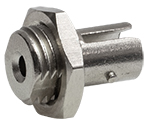
Click to Enlarge
LN3824 Lock Nut Secured to the HAST ST/PC Adapter
- Ideal for OEM or Custom Applications
- 2.0 mm Narrow-Key-Slot FC/PC Bulkhead Adapter
- 2.2 mm Wide-Key-Slot FC/PC Bulkhead Adapter
- SMA905- or SMA906-Style Bulkhead Adapter
- ST/PC Bulkhead Adapter and Compatible 3/8"-24 Lock Nut
- Useful for Fiber-to-Free-Space Interfaces
Thorlabs Bulkhead Adapters each accept a fiber connector on one side and have threads that can be used to mount the adapter into an OEM or custom system. They are useful for applications that require light to be launched from a fiber into a free-space setup. The design aligns the front face of the connector ferrule with the rear surface of the adapter, as shown in the photo to the right, and allows the fiber to be placed in near-physical contact with any optics or instruments that are placed after the adapter.
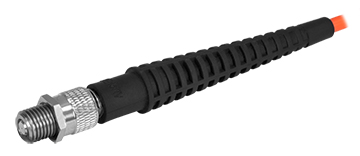
Click to Enlarge
HASMA Adapter Attached to an SMA-Terminated Fiber Patch Cable
For compatibility with FC/PC-terminated patch cables, we offer two bulkhead adapters: the HAFC2 with a 2.0 mm narrow-key slot and the HAFC with a 2.2 mm wide-key slot. Both adapters have 3.2 mm long, 3/8"-24 external mounting threads on the side opposite the FC/PC connector. To create 3/8"-24 taps in custom assemblies, Thorlabs offers the TAP3824 tap.
Our HASMA adapter is 0.38" (9.65 mm) long, with a 1/4"-36 threaded barrel for use with SMA905- and SMA906-style terminated fiber optic patch cables. The threaded barrel can also be used with the lock nut for mounting within OEM or custom systems.
The HAST adapter is a 0.58" (14.8 mm) long adapter for use with ST/PC terminated fiber optic patch cables. It has 0.18" (4.6 mm) of external 3/8"-24 external threads. The LN3824 Lock Nut, which has internal 3/8"-24 threads, may be purchased separately for mounting within OEM or custom systems. Both the HAST adapter and LN3824 are also available in packs of ten.
The uncommon mounting threads in these adapters will require the use of custom mounting solutions. The HAFC2, HAFC, and HASMA adapters may directly screw into an adapter plate. In order to mount the HAST adapter, the LN3824 lock nut must first be threaded onto the adapter (see the photo above). Once the lock nut is secure, the assembly may be threaded onto an adapter plate with a thread depth of at least 0.10" (2.54 mm). Please note that the HAST adapter and LN3824 lock nut are machined so that the maximum amount of torque needed to secure them into the adapter plate should not exceed 121.6 oz-lbs (0.86 N•m).
We recommend engaging at least two threads for stability when using a custom mount, with thread locker (Loctite) as an option for permanent solutions. If tapping a hole is not an option, the adapters can also be epoxied in place.
If a custom or OEM solution is not desired, the adapters are also available mounted within unthreaded and SM-threaded disks (sold above) for compatibility with our lens tube systems. Fiber and bulkhead caps are also available for preventing damage to the terminated fiber when it is not in use. For OEM inquiries, please contact techsales@thorlabs.com.

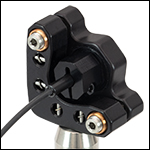
Click to Enlarge
An SM05LCM Adapter Shown in a KM05T SM05-Threaded Kinematic Mount with Ferrule-Terminated Patch Cable
- Adapters with Flexure Clamp for Patch Cables with Ø1.25 mm (LC) or Ø2.5 mm (FC) Ferrule Ends
- Externally SM05-Threaded (0.535"-40) Disks
- Light-Tight When Used with Ø1/2" Lens Tube
- Compatible with Our 16 mm Cage Plates
These Adapter Plates allow our patch cables with a Ø1.25 mm or Ø2.5 mm ferrule end to be mounted within SM05-threaded (0.535"-40) systems. A flexure clamp is used to secure the ferrule end of the patch cable; the SM05FCM clamps on a Ø2.5 mm bare ferrule while the SM105CM clamps on the Delrin®* sleeve of the Ø1.25 mm ferrule-terminated patch cables (see photo to the right).
The flexure clamp on each adapter is secured with a 2-56 cap screw, which is tightened using a 5/64" (2 mm) balldriver or hex key. Approximately 2.0 in-lbs (0.23 N·m) of torque is sufficient to secure the ferrule. When the ferrule is correctly positioned, the distance from the fiber end face to the adapter face is 0.01" (0.3 mm).
The disks are externally SM05-threaded (0.535"-40) and ensure that the ferrule adapters are light-tight when used with SM05-threaded (0.535"-40) lens tubes.
*Delrin® is a registered trademark of DuPont Polymers, Inc.

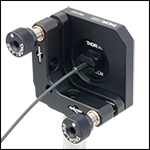
Click to Enlarge
An SM1LCM Adapter Shown in a KM100T SM1-Threaded Kinematic Mount with Ferrule-Terminated Patch Cable
- Adapters with Flexure Clamp for Patch Cables with Ø1.25 mm (LC) or Ø2.5 mm (FC) Ferrule Ends
- Externally SM1-Threaded (1.035"-40) Disks
- Light-Tight When Used with Ø1" Lens Tubes
- Compatible with Our 30 mm Cage Plates and Photodetectors
These Adapter Plates allow our patch cables with a Ø1.25 mm or Ø2.5 mm ferrule end to be mounted within SM1-threaded (1.035"-40) systems. A flexure clamp is used to secure the ferrule end of the patch cable; the SM1FCM clamps on a Ø2.5 mm bare ferrule while the SM1LCM clamps on the Delrin®* sleeve of the Ø1.25 mm ferrule-terminated patch cables (see photo to the right).
The flexure clamp on each adapter is secured with a 3-48 cap screw, which is tightened using a 5/64" (2 mm) balldriver or hex key. Approximately 1.25 in-lbs (0.14 N·m) of torque is sufficient to secure the ferrule. When the ferrule is correctly positioned, the distance from the fiber end face to the adapter face is 0.01" (0.3 mm).
The disks are externally SM1-threaded (1.035"-40) and have four dimples, two in the front surface and two in the back surface, that allow it to be tightened from either side using an SPW909 or SPW801 Spanner Wrench. These dimples do not pass through the disk, ensuring the ferrule adapters are light-tight when used with SM1-threaded (1.035"-40) lens tubes. Once the adapter is in the desired position, use an SM1RR retaining ring to secure it in place.
*Delrin® is a registered trademark of DuPont Polymers, Inc.

- Compact Flexure Clamps for Ø1.25 mm, Ø2.5 mm, Ø3.2 mm, or Ø3.4 mm Ferrules
- 8-32 (M4) Tapped Mounting Hole
- Compatible with Ø1/2" Optical Posts
These Post-Mountable Ferrule Clamps allow fiber connectors to be mounted securely and compactly within an experimental setup. See the table below for compatible ferrule diameters and fiber connectors for each clamp. The fiber ferrule is clamped into the flexure mount using a 5/64" (2 mm) hex key. An 8-32 (M4) tapped hole on the bottom of the mount provides compatibility with our Ø1/2" optical posts.
| Item # | Compatible Component Diameter | Compatible Components |
|---|---|---|
| FCM13(/M) | 1.25 mm (0.05") | Ø1.25 mm Ferrules |
| FCM(/M) | 2.5 mm (0.10") | Ø2.5 mm Ferrules, FC/PC, FC/APC, SC/PC, and ST®a/PC Connectors |
| FCM32(/M) | 3.2 mm (0.13") | SMA Connectors |
| FCM34(/M) | 3.4 mm (0.14") | GRIN Collimators |
 Products Home
Products Home






































































 Zoom
Zoom

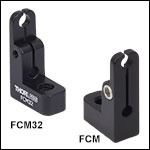
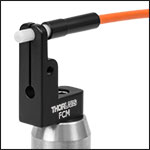
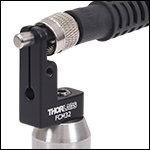
 Terminated Fiber Adapters
Terminated Fiber Adapters